 W
WThe rufous-capped babbler is a babbler species in the family Timaliidae. It occurs from the Eastern Himalayas to northern Thailand, Laos, eastern China to Vietnam and Taiwan. It inhabits foremost temperate forest and is listed as Least Concern on the IUCN Red List.
 W
WThe Taiwan scimitar babbler is a bird in the family Timaliidae, the Old World babblers. It is endemic to Taiwan. The species was first described by Robert Swinhoe in 1859. It was formerly treated as a subspecies of the streak-breasted scimitar babbler. Its population is declining, but not rapidly enough for it to be considered vulnerable.
 W
WThe Taiwan barwing or Formosan barwing is a species of bird in the family Leiothrichidae. It is found in Taiwan. Its natural habitats are temperate forests and subtropical or tropical moist lowland forests.
 W
WThe black bulbul, also known as the Himalayan black bulbul or Asian black bulbul, is a member of the bulbul family of passerine birds. It is found in southern Asia from India east to southern China. It is the type species of the genus Hypsipetes, established by Nicholas Aylward Vigors in the early 1830s. There are a number of subspecies, mostly varying in the shade of the body plumage which ranges from grey to black, and some also occur in white-headed morphs, as also suggested by its specific epithet leucocephalus, literally "white head". The legs and bill are always rich orange-red.
 W
WThe brown-eared bulbul is a medium-sized bulbul native to eastern Asia. It is extremely common within the northern parts of its range and can be found from southern Sakhalin to the northern Philippines.
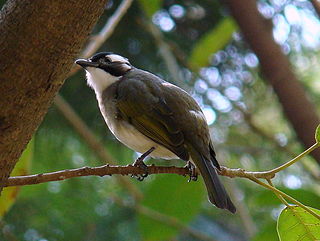 W
WThe light-vented bulbul is a species of bird in the bulbul family. It is found in central and southern China, northern Vietnam and Taiwan.
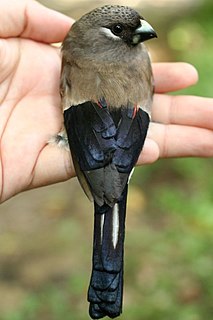 W
WThe brown bullfinch is a species of bird in the true finch family, Fringillidae. It is found in Bhutan, China, India, Malaysia, Myanmar, Nepal, Pakistan, Taiwan, and Vietnam. Its natural habitats are temperate forest and subtropical or tropical moist montane forest.
 W
WThe grey-headed bullfinch is a species of finch in the family Fringillidae. It is sometimes known as Beavan's bullfinch.
 W
WThe grey bush chat is a species of passerine bird in the family Muscicapidae. It is found in the Himalayas, southern China, Taiwan, Nepal and mainland Southeast Asia.
 W
WThe slaty-legged crake or banded crake is a waterbird in the rail and crake family, Rallidae.
 W
WThe black-chinned fruit dove, also known as the black-throated fruit dove or Leclancher's dove, is a medium-sized bird of the family Columbidae. The male is a colorful bird with a green belly and wings, a brown tail, a whitish grey head and neck with a purple base, red iris and a small black patch under its yellow bill. The female has a green head, neck and breast.
 W
WThe black drongo is a small Asian passerine bird of the drongo family Dicruridae. It is a common resident breeder in much of tropical southern Asia from southwest Iran through India, Bangladesh and Sri Lanka east to southern China and Indonesia and accidental visitor of Japan. It is an all black bird with a distinctive forked tail and measures 28 cm (11 in) in length. It feeds on insects, and is common in open agricultural areas and light forest throughout its range, perching conspicuously on a bare perch or along power or telephone lines. The species is known for its aggressive behaviour towards much larger birds, such as crows, never hesitating to dive-bomb any bird of prey that invades its territory. This behaviour earns it the informal name of king crow. Smaller birds often nest in the well-guarded vicinity of a nesting black drongo. Previously grouped along with the African fork-tailed drongo, the Asian forms are now treated as a separate species with several distinct populations.
 W
WThe bronzed drongo is a small Indomalayan bird belonging to the drongo group. They are resident in the forests of the Indian Subcontinent and Southeast Asia. They capture insects flying in the shade of the forest canopy by making aerial sallies from their perches. They are very similar to the other drongos of the region but are somewhat smaller and compact with differences in the fork depth and the patterns of gloss on their feathers.
 W
WThe mandarin duck is a perching duck species native to the East Palearctic. It is medium-sized, at 41–49 cm (16–19 in) long with a 65–75 cm (26–30 in) wingspan. It is closely related to the North American wood duck, the only other member of the genus Aix. Aix is an Ancient Greek word which was used by Aristotle to refer to an unknown diving bird, and galericulata is the Latin for a wig, derived from galerum, a cap or bonnet.
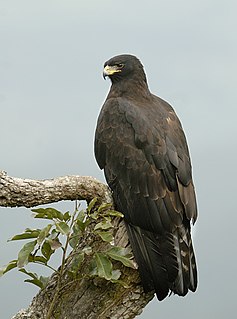 W
WThe black eagle. Like all eagles, it is in the family Accipitridae, and is the only member of the genus Ictinaetus. They soar over forests in the hilly regions of tropical and subtropical South and Southeast Asia, as well as southeastern China. They hunt mammals and birds, particularly at their nests. They are easily identified by their widely splayed and long primary "fingers", the characteristic silhouette, slow flight and yellow ceres and legs that contrast with their dark feathers.
 W
WThe white-bellied erpornis or simply erpornis is a species of bird. It is the only member of the genus Erpornis. This bird is found in Bangladesh, Bhutan, Brunei, Cambodia, China, India, Indonesia, Laos, Malaysia, Myanmar, Nepal, Singapore, Taiwan, Thailand, and Vietnam. Its natural habitat is subtropical or tropical moist montane forests.
 W
WThe collared finchbill is a species of songbird in the bulbul family, Pycnonotidae. It is found in China, Taiwan, Japan and Vietnam.
 W
WThe flamecrest or Taiwan firecrest, is a species of bird in the kinglet family, Regulidae, that is endemic to the mountains of the island of Taiwan.
 W
WThe fire-breasted flowerpecker is a species of bird in the family Dicaeidae found in the Indian Subcontinent and Southeast Asia. Like other flowerpeckers, this tiny bird feeds on fruits and plays an important role in the dispersal of fruiting plants. Unlike many other species in the genus, this species has marked sexual dimorphism with the male having contrasting upper and lower parts with a distinctive bright orange breast patch. The female is dull coloured.
 W
WThe little forktail is a species of bird in the family Muscicapidae.
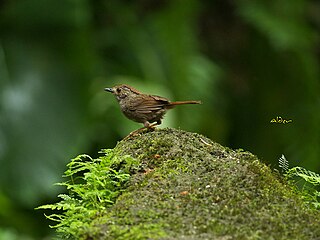 W
WThe dusky fulvetta is a species of bird in the family Pellorneidae. It is found in China and Taiwan. Its natural habitats are temperate forest and subtropical or tropical moist lowland forest.
 W
WThe grey-cheeked fulvetta is a bird in the family Alcippeidae. The species was first described by Robert Swinhoe in 1863.
 W
WThe Taiwan fulvetta is a bird species in the family Sylviidae. Like the other typical fulvettas, it was long included in the Timaliidae genus Alcippe. In addition, it was long included in F. cinereiceps as a subspecies.
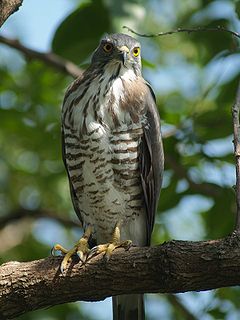 W
WThe crested goshawk is a bird of prey from tropical Asia. It is related to other diurnal raptors such as eagles, buzzards and harriers, and thus placed in the family Accipitridae.
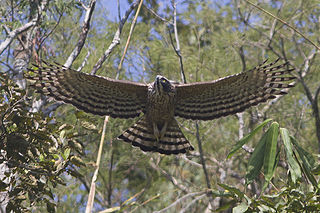 W
WThe mountain hawk-eagle or Hodgson's hawk-eagle, is a large bird of prey native to Asia. The latter name is in reference to the naturalist, Brian Houghton Hodgson, who described the species after collecting one himself in the Himalayas. A less widely recognized common English name is the feather-toed eagle. Like all eagles, it is in the family Accipitridae. Its feathered tarsus marks this species as a member of the subfamily Aquilinae. It is a confirmed breeding species in the northern part of the Indian subcontinent, from India, Nepal through Bangladesh to Thailand, Taiwan and Japan, although its distribution could be wider still as breeding species. Like other Asian hawk-eagles, this species was earlier treated under the genera of Spizaetus but genetic studies have shown this group to be paraphyletic, resulting in the Old World members being placed in Nisaetus and separated from the New World species. As is typical of hawk-eagles, the mountain hawk-eagle is a forest dwelling opportunistic predator who readily varies its prey selection between birds, mammals and reptiles along with other vertebrates. Although classified currently as a least-concern species due its persistence over a rather wide distribution, this species is often quite rare and scarce and seems to be decreasing, especially in response to large-scale habitat degradation and deforestation.
 W
WThe Chinese hwamei or melodious laughingthrush is a passerine bird of eastern Asia in the family Leiothrichidae. The name "hwamei" comes from the Chinese 画眉 (huà-méi) and means "painted eyebrow" referring to the distinctive marking around the bird's eyes. The species is a popular cagebird because of its attractive song.
 W
WThe crested ibis, also known as the Japanese crested ibis, Asian crested ibis or Toki (トキ), variously written in kanji as 朱鷺, 鴇, 鵇, 鴾, or 桃花鳥, and written in hanzi as 朱䴉 or 朱鷺, is a large, white-plumaged ibis of pine forests. Its head is partially bare, showing red skin, and it has a dense crest of white plumes on the nape. This species is the only member of the genus Nipponia.
 W
WThe grey-throated martin or Asian plain martin is a small passerine bird in the swallow family.
 W
WThe grey-chinned minivet is a species of bird in the family Campephagidae. It is found from the Himalayas to China, Taiwan and Southeast Asia. Its natural habitat is forests about 1,000–2,000 m (3,300–6,600 ft) in elevation. The International Union for Conservation of Nature (IUCN) has assessed it as a least-concern species.
 W
WThe crested myna, also known as the Chinese starling, is a species of starling in the genus Acridotheres native to southeastern China and Indochina. It is named after the tuft of feathers on its forehead that resembles a crest.
 W
WThe silver-backed needletail is a species of swift in the family Apodidae. It is found in Southeast Asia, Sumatra, Java and Taiwan. It is a vagrant to Christmas Island. Its natural habitat is subtropical or tropical moist lowland forests.
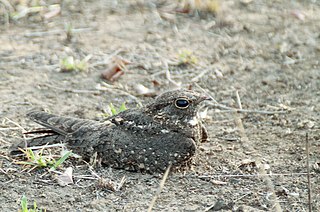 W
WThe savanna nightjar is a species of nightjar found in South and Southeast Asia. Eight subspecies are recognised: C. a. monticolus, C. a. amoyensis, C. a. stictomus, C. a. affinis, C. a. timorensis, C. a. griseatus, C. a. mindanensis and C. a. propinquus. Its habitat is open forest and areas with scrub. Its length is about 25 cm (9.8 in). The upperparts are brownish-grey and vermiculated, with pale brown speckles. The underparts are brown, with bars. The savanna nightjar is nocturnal. Its song is a squeaky kweek kweek. The IUCN Red List has assessed the species to be of least concern because it has a large range and its population trend is stable.
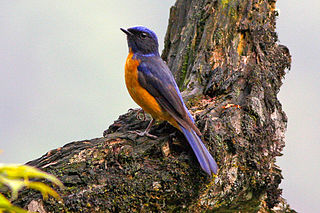 W
WThe vivid niltava is a bird in the family Muscicapidae. The species was first described by Robert Swinhoe in 1864. It is found from the Himalayas to China and Taiwan. Its natural habitat is subtropical or tropical moist montane forests. The vivid niltava a medium-sized (16 cm) member of the Old World flycatcher family, has a deep purplish blue on the head, back, tail and lesser wing coverts, and bright rufous orange below. Its throat, face, wings and iris are black as are its legs and bill. The female is olive brown overall, lighter below, with a light buffy throat and greyish-brown crown and nape. As do many members of its family, the vivid niltava bears distinct rictal bristles at the base of its bill. The Taiwan subspecies, N. v. vivida, is distinctly smaller than the mainland race N. v. oatesi.
 W
WThe black-naped oriole is a passerine bird in the oriole family that is found in many parts of Asia. There are several distinctive populations within the wide distribution range of this species and in the past the slender-billed oriole was included as a subspecies. Unlike the Indian golden oriole which only has a short and narrow eye-stripe, the black-naped oriole has the stripe broadening and joining at the back of the neck. Males and females are very similar although the wing lining of the female is more greenish. The bill is pink and is stouter than in the golden oriole.
 W
WThe maroon oriole is a species of bird in the family Oriolidae. It is found in Southeast Asia.
 W
WThe tawny fish owl is a fish owl species in the family known as typical owls, Strigidae. It is native from southern Nepal to Bangladesh, Vietnam and China. Due to its wide geographical distribution, it is listed as Least Concern on the IUCN Red List.
 W
WThe golden parrotbill is a species of parrotbill in the family Sylviidae. It is found in China, Laos, Myanmar, Taiwan, and Vietnam. Its natural habitat is subtropical or tropical moist montane forests.
 W
WThe Taiwan bamboo partridge is a species of bird in the family Phasianidae. It is endemic to Taiwan. It was formerly considered a subspecies of the Chinese bamboo partridge.
 W
WThe Taiwan partridge or Taiwan hill partridge is a species of bird in the family Phasianidae. It is found only in Taiwan, and its natural habitat is broadleaf forests. It is threatened by habitat loss, but at present is categorised by the International Union for Conservation of Nature (IUCN) as being of least concern.
 W
WThe whistling green pigeon is a bird in the family Columbidae. The species was first described by Robert Swinhoe in 1863. It is found in Taiwan, the Ryukyu Islands and Batanes. Its natural habitats are subtropical or tropical moist lowland forests and rural gardens. It is threatened by habitat loss.
 W
WThe white-bellied green pigeon is a species of bird in the family Columbidae. It is found in China, Japan, South Korea, Laos, Russia, Taiwan, Thailand, India and Vietnam. Its natural habitat is temperate forests.
 W
WThe ashy wood pigeon is a species of bird in the family Columbidae, found in temperate forests of southeastern Asia.
 W
WThe fairy pitta is a small and brightly colored passerine bird that mainly feeds on earthworms, spiders, insects, slugs, and snails. It is also called “little forest angel” in Taiwan and “eight colored bird" in Japan, Taiwan, North Korea and South Korea. The fairy pitta breeds in East Asia and migrates south to winter in Southeast Asia. Due to various habitat and anthropogenic disruptions, such as deforestation, wildfire, hunting, trapping, and cage-bird trade, the fairy pitta is rare and the population is declining in most places. Listed on the Convention on International Trade in Endangered Species of Wild Fauna and Flora (CITES) Appendix II, this bird is classified as vulnerable on The IUCN Red List of Threatened Species.
 W
WThe white-browed bush robin is a species of bird in the family Muscicapidae. It is found from the Himalayas to south-central China and Taiwan. Its natural habitat is Rhododendron and conifer forests.
 W
WThe white-tailed robin is an Old World flycatcher in the family Muscicapidae. It ranges across the northern regions of the Indian subcontinent and adjacent areas of Southeast Asia. It is found in Bangladesh, Bhutan, Cambodia, India, Laos, Malaysia, Myanmar, Nepal, Taiwan, Thailand, and Vietnam. Its natural habitats are subtropical or tropical moist lowland forest and subtropical or tropical moist montane forest.
 W
WThe Taiwan rosefinch is a species of finch in the family Fringillidae. It was formerly considered a subspecies of the vinaceous rosefinch. It is endemic to Taiwan. Its natural habitats are temperate forests and subtropical or tropical dry forests.
 W
WThe white-browed shortwing is a species of chat. This species is now classified in the family Muscicapidae.
 W
WThe striated swallow is a species of swallow found in open, often hilly areas, clearings and cultivation in South and Southeast Asia to northeastern India and Taiwan.
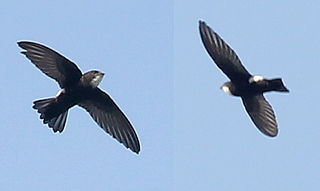 W
WThe house swift is a species of swift in the family Apodidae. It is found in Japan, Nepal, and Southeast Asia. It is capable of flying long distances by alternately shutting off hemispheres of their brain in-flight. In May 2012, one was discovered in Ladner, British Columbia, the first known sighting in North America.
 W
WThe island thrush is a common forest bird in the thrush family. Almost 50 subspecies have been described, ranging from Taiwan, through South East Asia and Melanesia, to Samoa, exhibiting great differences in plumage. Several subspecies are threatened and three have already become extinct.
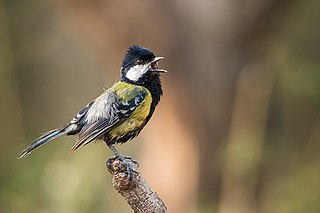 W
WThe green-backed tit is a species of bird in the family Paridae.
 W
WThe yellow tit, Taiwan yellow tit, or Formosan yellow tit is a species of bird in the family Paridae. It is endemic to central Taiwan.
 W
WThe grey treepie, also known as the Himalayan treepie, is an Asian treepie, a medium-sized and long-tailed member of the crow family. The species was first described by Robert Swinhoe in 1863. They are widely distributed along the foothills of the Himalayas in the Indian Subcontinent and extending into Indochina, southern mainland China and Taiwan. The populations vary in plumage and several are named as subspecies.
 W
WThe brown-flanked bush warbler, also known as the brownish-flanked bush warbler, is a species of bush-warbler of the family Cettiidae. It was formerly included in the "Old World warbler" assemblage. It is found in South Asia.
 W
WThe rufous-faced warbler is a species of the bush warbler family, Cettiidae. It was formerly included in the "Old World warbler" assemblage.